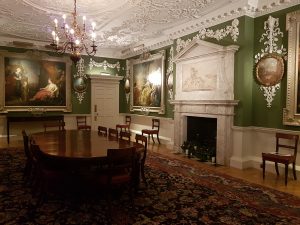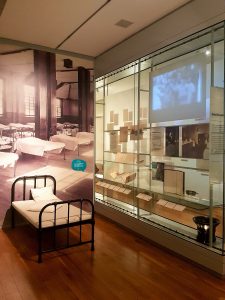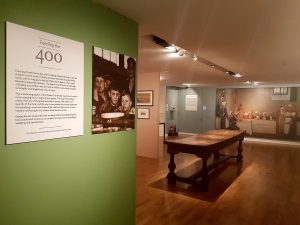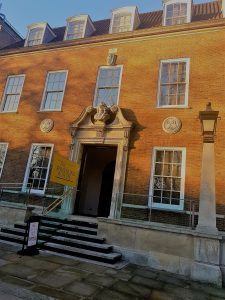
Foundling Museum Court Room
The small but grand building for the Foundling Museum is tucked away in a corner of London rarely visited by your traditional tourist. Upon finding it, however, I found a fantastic little museum with great potential.
We entered the museum not really knowing what to expect and were greeted by friendly staff who pointed us in the right direction. The first stop was the permanent exhibition, and for the next hour, we whiled away the minutes lost in the history of the Foundling Hospital and the personal stories of those children who had lived there.

Permanent Exhibition
The Foundling Hospital was founded in 1739 by Thomas Coram, who was appalled at the sight of so many abandoned and starving children in London. During the early 1700s, the city was facing an ever growing population, and a time of hardship. Illegitimacy was high and carried with it the heavy stigma of immorality. Thomas campaigned to change this and finally received a Royal Charter signed by King George II to set up the Foundling Hospital. Staff moved into a temporary building on 14th March 1741. The same evening they admitted the first babies to the hospital. They would later move into a purpose built house designed by Theodore Jacobsen. As you pass the exhibition cases, you see the admission books with the sex, age, date of admission, and description of the child. The next stage for these children was to be given a unique number that would be worn around their neck at all times from that point onwards. They were then dressed and given a new name before sent to a temporary foster family. It was heart-breaking to read tales of some mothers abandoning their children due to poverty or circumstance. Then, turning around to the opposite wall, I found on display a handful of the 18,000 or so identity tokens left by mothers with their children. It was a powerful image.
Moving through the rest of the exhibition, we discovered more about how the children were cared for after they returned to the hospital at the age of five. Their lives changed to one that embodied strict routine on a daily basis. Through a film, we heard the voices of individuals talking about school life over photographs displayed on the screen. Foundlings, as they became known, were apprenticed as soon as the hospital was able to after they turned fourteen. Leafing through the guidebook at this stage, I found more detail about the types of apprenticeships the foundlings went into. This linked well to the small display that looked at the “ground-breaking” approach to the care and education of the disabled children who attended the hospital. Personal stories on from these children were easily accessible to read on a tablet nearby and told some fantastic tales, which left me wanting to know more.

Feeding the 400 exhibition
We moved on from the permanent exhibition to the “Feeding the 400” temporary exhibition across the hall. This exhibition built a picture of the foundlings‚Äô experiences of food whilst at the hospital. All thoughts of wooden tableware were set aside instantly with a display of china plates the children ate from. The scene was then set for the rest of the exhibition with a long wooden table stationed in the centre of the room and background noises of children eating. The children were fed the stereotypical gruel at breakfast each day without fail, but we discover a whole variety of other foods the children ate. Among these were whole-fat milk, tea, coffee, beer, and a range of different puddings. Meat was served regularly, although never roasted as it was too expensive. On one occasion, the children were even given half a pound of chocolate each. We discover that the hospital was rocked with scandal in 1811 after it came to light that the children had been drinking semi-skimmed milk, instead of the standard whole-fat. It was interesting to find out that a popular activity for the upper classes was to take in a viewing of the children at their Sunday dinner after the weekly chapel service. This seems strange to us now, and even invasive. Stealing away from this uncomfortable discovery, I found invoices and notes on puddings. One note rejected donations of broken biscuits from a shop with the reason that it was too difficult to give the children an equal portion. This surprise finding led me to the final stage of the exhibition where recordings made by past foundlings waited to tell their stories about the food they ate whilst at the hospital.

Entrance
The Foundling Museum holds so much potential and addresses a subject matter that is important to the history of London. This museum is one of London’s hidden gems. Yet, there were times when I wanted to know more. I wanted to learn more about the daily routines the children had and what happened after they finished their apprenticeships, especially those children deemed unsuitable and sent back to the hospital. The exhibitions themselves remained vague on what life was like specifically for girls and boys. This seems strange due to the long-held tradition of gender segregation within society. Despite these niggles, though, I found myself lapping up the information contained within the exhibitions and wanting to discover more through my own research. That is surely a sign of an excellent museum visit!
To discover more about the museum and the exhibitions currently on show, check out their website.
-Claire Amundson
Junior Girl
Girl Museum Inc.
